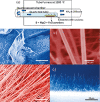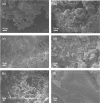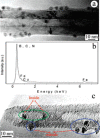Synthesis of boron nitride nanotubes and their applications
- PMID: 25671154
- PMCID: PMC4311706
- DOI: 10.3762/bjnano.6.9
Synthesis of boron nitride nanotubes and their applications
Abstract
Boron nitride nanotubes (BNNTs) have been increasingly investigated for use in a wide range of applications due to their unique physicochemical properties including high hydrophobicity, heat and electrical insulation, resistance to oxidation, and hydrogen storage capacity. They are also valued for their possible medical and biomedical applications including drug delivery, use in biomaterials, and neutron capture therapy. In this review, BNNT synthesis methods and the surface modification strategies are first discussed, and then their toxicity and application studies are summarized. Finally, a perspective for the future use of these novel materials is discussed.
Keywords: boron nitride nanotubes; chemical modifications; medical applications; synthesis methods; toxicity.
Figures









Similar articles
-
Synthesis, Functionalization, and Bioapplications of Two-Dimensional Boron Nitride Nanomaterials.Front Bioeng Biotechnol. 2019 Dec 10;7:363. doi: 10.3389/fbioe.2019.00363. eCollection 2019. Front Bioeng Biotechnol. 2019. PMID: 31921797 Free PMC article. Review.
-
Boron nitride nanotubes included thermally cross-linked gelatin-glucose scaffolds show improved properties.Colloids Surf B Biointerfaces. 2016 Feb 1;138:41-9. doi: 10.1016/j.colsurfb.2015.11.036. Epub 2015 Nov 23. Colloids Surf B Biointerfaces. 2016. PMID: 26642075
-
Boron Nitride Nanotube (BNNT) Membranes for Energy and Environmental Applications.Membranes (Basel). 2020 Dec 16;10(12):430. doi: 10.3390/membranes10120430. Membranes (Basel). 2020. PMID: 33339291 Free PMC article.
-
Growth methodologies of boron nitride nanotubes and their neutron shielding applications: a review.Nanoscale. 2024 Feb 22;16(8):3817-3837. doi: 10.1039/d3nr06070e. Nanoscale. 2024. PMID: 38327235 Review.
-
Boron nitride nanotubes: synthesis and applications.Nano Converg. 2018;5(1):17. doi: 10.1186/s40580-018-0149-y. Epub 2018 Jun 28. Nano Converg. 2018. PMID: 30046512 Free PMC article. Review.
Cited by
-
Hybrid Ni-Boron Nitride Nanotube Magnetic Semiconductor-A New Material for Spintronics.ACS Omega. 2020 Aug 4;5(32):20014-20020. doi: 10.1021/acsomega.0c01408. eCollection 2020 Aug 18. ACS Omega. 2020. PMID: 32832755 Free PMC article.
-
Dynamic thin film mediated slicing of boron nitride nanotubes.Nanoscale Adv. 2019 Oct 23;1(12):4722-4728. doi: 10.1039/c9na00481e. eCollection 2019 Dec 3. Nanoscale Adv. 2019. PMID: 36133138 Free PMC article.
-
One-Step Synthesis of Hexagonal Boron Nitrides, Their Crystallinity and Biodegradation.Front Bioeng Biotechnol. 2018 Jun 21;6:83. doi: 10.3389/fbioe.2018.00083. eCollection 2018. Front Bioeng Biotechnol. 2018. PMID: 29977891 Free PMC article.
-
Adsorption of carbon dioxide and ammonia in transition metal-doped boron nitride nanotubes.J Mol Model. 2019 Nov 26;25(12):359. doi: 10.1007/s00894-019-4235-9. J Mol Model. 2019. PMID: 31773288
-
Alignment of Boron Nitride Nanofibers in Epoxy Composite Films for Thermal Conductivity and Dielectric Breakdown Strength Improvement.Nanomaterials (Basel). 2018 Apr 15;8(4):242. doi: 10.3390/nano8040242. Nanomaterials (Basel). 2018. PMID: 29662038 Free PMC article.
References
-
- Golberg D, Bando Y, Tang C C, Zhi C Y. Adv Mater. 2007;19:2413–2432. doi: 10.1002/adma.200700179. - DOI
-
- Sauti G, Park C, Kang J H, Kim J-W, Harrison J S, Smith M W, Jordon K, Lowther S E, Lillehei P T, Thibeault S A, inventors. 2013/0119316 A1. U.S. Pat. Appl. 2013 May 16;
-
- Cohen M L, Zettl A. Phys Today. 2010;63:34–38. doi: 10.1063/1.3518210. - DOI
Publication types
LinkOut - more resources
Full Text Sources
Other Literature Sources
